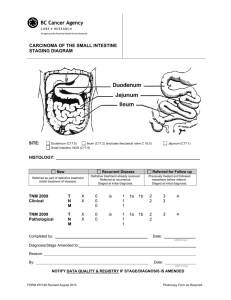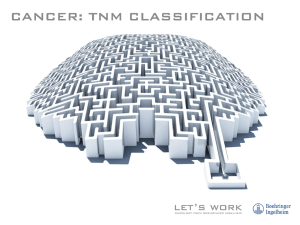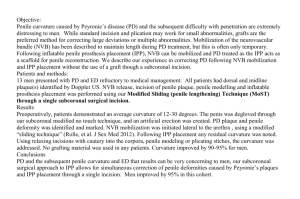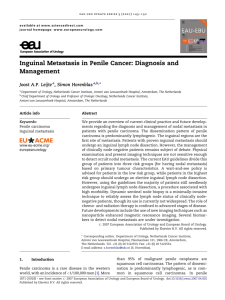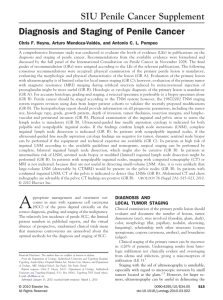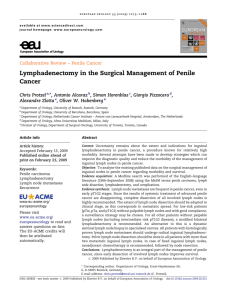GUIDELINES ON PENILE CANCER - Uroweb
advertisement
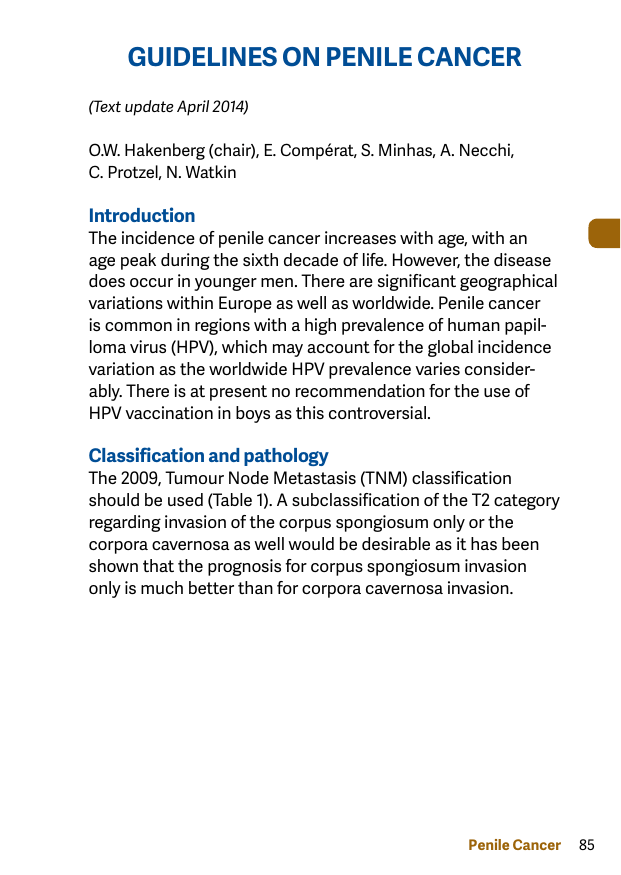
GUIDELINES ON PENILE CANCER (Text update April 2014) O.W. Hakenberg (chair), E. Compérat, S. Minhas, A. Necchi, C. Protzel, N. Watkin Introduction The incidence of penile cancer increases with age, with an age peak during the sixth decade of life. However, the disease does occur in younger men. There are significant geographical variations within Europe as well as worldwide. Penile cancer is common in regions with a high prevalence of human papilloma virus (HPV), which may account for the global incidence variation as the worldwide HPV prevalence varies considerably. There is at present no recommendation for the use of HPV vaccination in boys as this controversial. Classification and pathology The 2009, Tumour Node Metastasis (TNM) classification should be used (Table 1). A subclassification of the T2 category regarding invasion of the corpus spongiosum only or the corpora cavernosa as well would be desirable as it has been shown that the prognosis for corpus spongiosum invasion only is much better than for corpora cavernosa invasion. Penile Cancer 85 Table 1: 2009 TNM clinical and pathological classification of penile cancer Clinical Classification T - Primary Tumour TX Primary tumour cannot be assessed T0 No evidence of primary tumour Tis Carcinoma in situ Ta Noninvasive verrucous carcinoma T1 Tumour invades subepithelial connective tissue T2 Tumour invades corpus spongiosum or cavernosum T3 Tumour invades urethra or prostate T4 Tumour invades other adjacent structures N - Regional Lymph Nodes NX Regional lymph nodes cannot be assessed N0 No regional lymph node metastasis N1 Metastasis in a single superficial inguinal lymph node N2 Metastasis in multiple or bilateral superficial inguinal lymph nodes N3 Metastasis in deep inguinal or pelvic lymph node(s), unilateral or bilateral M - Distant Metastasis MX Distant metastasis cannot be assessed M0 No distant metastasis M1 Distant metastasis pTNM Pathological Classification The pT, pN and pM categories correspond to the T, N, and M categories. pN - Regional Lymph Nodes pNX Regional lymph nodes cannot be assessed pN0 No regional lymph node metastasis 86 Penile Cancer pN1 pN2 Intranodal metastasis in a single inguinal lymph node Metastasis in multiple or bilateral inguinal lymph nodes pN3 Metastasis in pelvic lymph node(s), unilateral or bilateral or extranodal extension of any regional lymph node metastasis pM - Distant Metastasis pM0 No distant metastasis pM1 Distant metastasis G - Histopathological Grading GX Grade of differentiation cannot be assessed G1 Well differentiated G2 Moderately differentiated G3-4 Poorly differentiated/undifferentiated Pathology Squamous cell carcinoma (SCC)in different variants accounts for > 95% of cases of malignant penile disease. Table 2 lists premalignant lesions and Table 3 lists the pathological subtypes of penile carcinomas. Table 2: Premalignant penile lesions (precursor lesions) • Cutaneous horn of the penis • Bowenoid papulosis of the penis • Lichen sclerosus (balanitis xerotica obliterans) Premalignant lesions (up to one-third transform to invasive SCC) • Intraepithelial neoplasia grade III • Giant condylomata (Buschke-Löwenstein) • Erythroplasia of Queyrat • Bowen’s disease • Paget’s disease (intradermal ADK) Penile Cancer 87 Diagnosis and staging of penile cancer Penile cancer can be cured in > 80% of cases but it is a lifethreatening disease with poor prognosis once metastatic spread has occurred. Local treatment, although potentially life-saving, can be mutilating and devastating for the psychological well-being of the patient supporting the need for careful diagnosis and adequate staging before any treatment decisions can be made. Biopsy In the management of penile cancer there is need for histological confirmation if: • there is doubt about the exact nature of the lesion (e.g. CIS, metastasis or melanoma) and/or; • treatment with topical agents, radiotherapy or laser surgery is planned. 88 Penile Cancer Table 3: Histological subtypes of penile carcinomas, their frequency and prognosis Subtype Frequency Prognosis (%) common SCC 48-65 depends on location, stage and grade basaloid 4-10 poor prognosis, frequently early carcinoma inguinal nodal metastasis warty 7-10 good prognosis, metastasis rare carcinoma verrucous 3-8 good prognosis, no metastasis carcinoma papillary 5-15 good prognosis, metastasis rare carcinoma sarcomatoid 1-3 very poor prognosis, early carcinoma vascular metastasis mixed 9-10 heterogenous group carcinoma pseudohyper- <1 foreskin, related to lichen plastic sclerosus, good prognosis, carcinoma metastasis not reported carcinoma <1 variant of verrucous carcinoma, cuniculatum good prognosis, metastasis not reported pseudoglan- <1 high grade carcinoma, early dular metastasis, poor prognosis carcinoma warty9-14 poor prognosis, high metastatic basaloid potential, (higher than warty, carcinoma lower than basaloid SCC) Penile Cancer 89 adenosquamous carcinoma <1 mucoepidermoid carcinoma clear cell variant of penile carcinoma <1 1-2 central and peri-meatal glans, high grade carcinoma, high metastatic potential but low mortality highly aggressive, poor prognosis exceedingly rare, associated with HPV, aggressive, early metastasis, poor prognosis, outcome lesion dependent, frequent lymphatic metastasis Physical Examination Physical examination of a patient with penile cancer should include palpation of the penis to examine the extent of local invasion and careful examination of the groins for regional lymph node enlargement. Imaging • Ultrasound (US) can give information about infiltration of the corpora. • Magnetic resonance imaging (MRI) in combination with an artificial erection with prostaglandin E1 may be used for excluding tumour invasion of the corpora cavernosa if organ-preservation is planned and preoperative decisions are needed. • In case of non-palpable inguinal nodes current imaging techniques are not reliable in detecting micro-metastases. • A pelvic CT scan can be performed to assess pelvic lymph nodes. • In case of positive inguinal nodes, CT of the abdomen and pelvis and a chest X-ray are recommended; a thoracic CT will be more sensitive than an X-ray. 90 Penile Cancer Recommendations for the diagnosis and staging of penile cancer Primary tumour Physical examination, recording morphology, extent and invasion of penile structures. MRI with artificial erection in selected cases with intended organ preserving surgery. Inguinal lymph nodes Physical examination of both groins, recording number, laterality and characteristics of inguinal nodes • If nodes are not palpable, invasive lymph node staging in high-risk patients. • If nodes are palpable, a pelvic CT may be indicated, PET/CT is an option. Distant metastases In N+ patients, abdomino-pelvic CT scan and chest X-ray are required for systemic staging. PET/CT scan is an option. In patients with systemic disease or with relevant symptoms, a bone scan may be indicated. CT = computed tomography; MRI = magnetic resonance imaging; PET = positron emission tomography. GR C C C Treatment The aims of the treatment of the primary penile cancer lesion are complete tumour removal with as much organ preservation as possible while radicality of the treatment should not be compromised. Penile Cancer 91 Guidelines for stage-dependent local treatment of penile carcinoma Primary tumour Conservative treatment is to LE GR be considered whenever possible Tis Topical treatment with 5-fluor- 3 C ouracil or imiquimod for superficial lesions with or without photodynamic control Laser ablation with CO2 or Nd:YAG laser Glans resurfacing Ta, T1a (G1, G2) Wide local excision with 3 C circumcision CO2 or Nd:YAG laser surgery with circumcision Laser ablation with CO2 or Nd:YAG laser Glans resurfacing Glansectomy with reconstructive surgery, with or without skin grafting Radiotherapy by external beam 3 C or as brachytherapy for lesions < 4 cm 92 Penile Cancer T1b (G3) and T2 confined to the glans Wide local excision plus reconstructive surgery, with or without skin grafting Laser ablation with circumcision Glansectomy with circumcision, with reconstruction Radiotherapy by external beam or brachytherapy for lesions < 4 cm in diameter T2 with invasion Partial amputation and of the corpora reconstruction cavernosa Radiotherapy by external beam or brachytherapy for lesions < 4 cm in diameter T3 with invasion Partial penectomy or total of the urethra penectomy with perineal urethrostomy T4 with invasion Neoadjuvant chemotherapy of other adjacent followed by surgery in structures responders Alternative: palliative external beam radiation. Local recurrence Salvage surgery with penisafter conservasparing treatment in small tive treatment recurrences or partial amputation. 3 C 3 C 3 C 3 C 3 C C Large or high stage recurrence: 3 partial or total amputation. CO2 = carbon dioxide; Nd:YAG = neodymium:yttrium-aluminium-garnet. Penile Cancer 93 Management of inguinal lymph nodes The treatment of regional lymph nodes is crucial for the survival of the patient. A surveillance strategy carries considerable risk as regional lymph node recurrence dramatically reduces the chance of long-term survival. Invasive staging by modified inguinal lymphadenectomy or dynamic sentinel node biopsy is recommended for penile cancers pT1G2 and higher. Guidelines for treatment strategies for nodal metastases Regional lymph nodes LE GR 2a B > T1G2: invasive lymph node 2a staging by bilateral modified inguinal lymphadenectomy or DSNB. Palpable Radical inguinal inguinal nodes lymphadenectomy (cN1/cN2) Fixed inguinal Neoadjuvant chemotherapy follymph nodes lowed by radical inguinal (cN3) lymphadenectomy in responders Pelvic Ipsilateral pelvic lymphadenec2a lymphadenec- tomy is indicated if two or more tomy inguinal nodes are involved on one side (pN2) and in extracapsular nodal metastasis (pN3) Adjuvant Indicated in pN2/pN3 patients 2b chemoafter radical lymphadenectomy therapy Radiotherapy Radiotherapy is not indicated for the treatment of nodal disease in penile cancer DSNB = dynamic sentinel node biopsy. B No palpable inguinal nodes (cN0) 94 Penile Cancer Management of regional lymph nodes is fundamental in the treatment of penile cancer Tis, Ta G1, T1G1: surveillance B B Guidelines for chemotherapy in penile cancer patients Adjuvant chemotherapy (3-4 cycles of TPF) is an option for patients with pN2-3 tumours. Neoadjuvant chemotherapy (4 cycles of a cisplatin and taxane-based regimen) followed by radical surgery is recommended in patients with non-resectable or recurrent lymph node metastases. Chemotherapy for systemic disease is an option in patients with limited metastatic load. TPF = cisplatin, 5FU plus paclitaxel or docetaxel. LE GR 2b C 2a B 3 C Follow-up Follow-up after curative treatment in penile carcinoma as in any malignant disease is important for two reasons: • early detection of recurrence allows for potentially curative treatment; • the detection and management of treatment-related complications. Local recurrence does not significantly reduce long-term survival if successfully treated while inguinal nodal recurrence leads to a drastic reduction in the probability of long-term disease-specific survival. Penile Cancer 95 Guidelines for follow-up in penile cancer Interval of follow-up Years 1-2 Follow-up of the primary tumour Penile preserving 3 months treatment Years 3-5 Amputation 1 year 3 months 6 months Follow-up of the inguinal lymph nodes Surveillance 3 months 6 months pN0 at initial treatment 3 months 1 year pN+ at initial treatment 3 months 6 months CT = computed tomography; FNAC = fine-needle aspiration cytology; Quality of life Overall, nearly 80% of penile cancer patients of all stages can be cured. Partial penectomy has negative consequences for the patients’ self-esteem and sexual function. Organpreserving treatment allows for better quality of life and sexual function and should be offered to all patients whenever feasible. Referral to centres with experience is recommended and psychological support is very important for penile cancer patients. 96 Penile Cancer Examinations and investigations Maximum duration of follow-up GR Regular physician or self-examination. Repeat biopsy after topical or laser treatment for CIS. Regular physician or self-examination. 5 years C 5 years C 5 years C 5 years C 5 years C Regular physician or self-examination. Regular physician or self-examination. US with FNAC optional Regular physician or self-examination. US with FNAC optional CT/MRI optional. US = ultrasound. This short booklet text is based on the more comprehensive EAU guidelines (ISBN 978-90-79754-65-6), available to all members of the European Association of Urology at their website, http://www.uroweb.org. Penile Cancer 97

